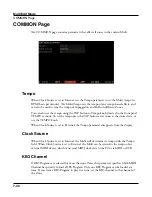
Multi Edit Mode
CONTROLS Page
7-25
Selecting Key (Root Note):
Shift Key (ShiftKey, controller destination 177) allows the user to select the key (root note)
of the Shift Pattern triggered by Shift Key Number. A Shift Pattern is a relative pattern based
on a root note. All notes triggered by a Shift Pattern are shifted from the root note by the
value of each pattern step (in half-steps.)
Shift Key Settings
Value
Key (Root note)
0-9
C
10-19
C#
20-29
D
30-39
D#
40-49
E
50-59
F
60-68
F#
69-78
G
79-88
G#
89-98
A
99-108
A#
109-118
B
119-127
Last Note Played
When using a Shift Pattern with Shift Key Number you can select the key with one or more
controllers assigned to the Shift Key destination. (Make sure this assignment uses the same
Zone as ShKeyNum.) You can use a continuous controller such as a slider to cycle through
keys, or switches set to predetermined keys. For example, if you are playing a song that
moves between 2 or 3 keys, a couple of switches could be programmed in order to send the
appropriate Shift Key message for each key change. That way all the notes you are triggering
with a Shift Key Number controller will be in the appropriate scale. You could also create
a Multi for a song with multiple zones, each with its own pre-set key and appropriate shift
pattern. That way, for each chord change you could move a different controller that would
create the correct harmony.
Another way to choose a key is to set Shift Key to Last Note Played mode, in which the
last note played in the zone will set the key. For example, you could set the zone being used
for Shift Key Number to have a Key Range that covers only a few of the keyboard’s lowest
octaves. This would allow you to play root note bass lines that change the key that Shift Key
Number plays in, leaving the upper octaves of the keyboard open for use by other zones.
A Note About Octave Range:
When using Shift Key Number, shift patterns with more than 12 steps begin triggering notes
in higher octaves. This is done because longer shift patterns use up more of a controller’s
range, and limit the number of octaves that a single controller can trigger. Since the lowest
octave of a program is often too low to be musically useful, the PC4 will automatically
start triggering notes from longer shift patterns in higher octaves. This saves room in the
controller’s range of values for triggering more useful octaves. See the table below for Shift
Pattern step ranges and their corresponding starting octave.
Содержание Flash Play PC4
Страница 1: ... It s the sound Part Number 910587 002 Rev B ...
Страница 9: ... ix MIDI Implementation A 1 Specifications B 1 Index I 1 ...
Страница 289: ... 8 40 ...
Страница 328: ... 10 7 ...
















































